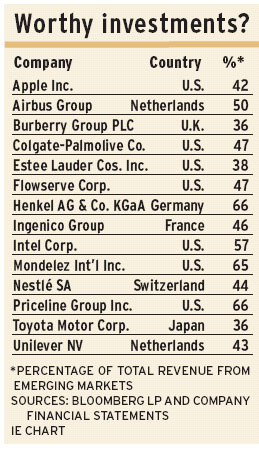
As multinational corporations (MNC) based in developed countries increasingly seek to leverage growth opportunities in fast-growing emerging markets, they offer your clients the ability to get exposure to emerging markets without investing directly in those markets.
However, there is no consensus about whether developed-markets stocks can offer enough exposure to emerging markets for your clients – especially those who view emerging markets as being too risky to invest in directly.
Nevertheless, emerging markets are growing significantly faster, on average, than developed markets. According to the International Monetary Fund’s World Economic Outlook report, 66% of global growth in 2015 expected to come from emerging markets.
As a result, says David Kunselman, senior portfolio manager and chief compliance officer with Excel Funds Management Inc. in Mississauga, Ont.: “A growing number of MNCs that have operations in emerging markets are deriving a significant portion of their revenue and profits from these markets.”
In fact, more than 75% of MNCs expect to gain market share in emerging markets, although most executives with MNCs believe they have not yet cracked the code to succeed against local competition, according to a survey of MNC executives conducted by Boston Consulting Group in 2013.
But MNCs that have succeeded have done well. “Some [MNCs] have a long-established presence in emerging markets, and these markets can make up a substantial portion – sometimes, the majority – of their profits and growth,” says Matt Moody, vice president and portfolio manager with Mackenzie Financial Corp.’s Ivy Funds team in Toronto.
For example, he says, Netherlands-based Unilever NV and New York-based Colgate-Palmolive Co., both consumer-goods companies, “have been in emerging markets for decades and are established leaders in their field” – in Latin America and India, respectively.
“An investment in these companies, or in a mutual fund that holds [shares in] several of these companies, is a good way to get exposure to leading businesses in emerging markets, even though the companies may be domiciled in developed markets,” Moody adds. “How much exposure you get depends on the proportion of the companies’ profits that are derived from emerging markets.”
But Serge Pépin, global emerging markets specialist with LGM Investments, a division of BMO Global Asset Management Inc., in Toronto, argues that you “never know to what extent revenue is derived from emerging markets and whether the amount of revenue will change from year to year.”
That’s because such information is not always disclosed in a company’s financial statements; and when it is disclosed, it often is buried in the notes to the statements.
Furthermore, the revenue of the foreign operations of some MNCs might not be reflected in the income statements of the parent company because the operations might not be wholly owned or might be separate or partial entities, Pépin suggests. For example, Wal-Mart de México y Centroamérica SAB de CV is a Mexico-based public corporation that is partially owned by a holding company subsidiary of Arkansas-based Wal-Mart Stores Inc.
That’s not always the case. MNCs with established operations in emerging markets typically disclose the percentage of revenue derived from those markets, Kunselman says. Such firms include: Illinois-based Mondelez International Inc., a confectionery, food and beverage conglomerate that derives 65% of its revenue from emerging markets; Airbus Group, a Netherlands-registered aerospace and defence company (50%); Henkel AG & Co. KGaA, a Germany-based manufacturing company (66%); and Nestlé SA, a Switzerland-based food and beverage company (44%).
“Disclosure of regional revenue and profit breakdowns varies a lot from company to company,” says Paul Musson, senior vice president, investment management and head of Mackenzie Financial’s Ivy Funds team in Toronto. “For some, it’s very clear how much of their business comes from emerging markets, while for others, it involves a bit of guesswork. The ones with substantial operations and success in emerging markets are, of course, generally more likely to provide good disclosure, [with some companies] publishing the proportion of their revenue that comes from emerging markets as well as the growth rates and, in some cases, the profitability.”
Also worth noting, Kunselman says, is that emerging markets are benefiting from rapid industrialization and urbanization and increasing per capita incomes, which will fuel higher domestic demand for goods and services – contributing to the growth of MNCs operating in these markets. Colgate-Palmolive, for example, is benefiting from “close to 10% revenue growth in emerging markets vs 2% revenue growth in the U.S.”
In addition, many MNCs also reinvest their profits in emerging markets, leading to an increase in the size of their operations and, consequently, greater revenue, Kunselman says.
The scope for investing in MNCs with emerging-markets exposure is growing as more emerging markets relax their foreign investment restrictions, he suggests, creating more opportunities for investors. “[This increasing investment also] puts pressure on [MNCs’] direct competitors to follow suit,” he claims, leading to even more opportunities.
Thus, investing in developed market-based MNCs with successful operations in emerging markets might make sense for some investors. But, Pépin argues, taking this route “just for the sake of getting emerging-markets exposure may result in missing out on opportunities offered by direct plays” in these markets. As an alternative, he suggests investing in a “stock-picking fund” focused on emerging markets.
Although that’s a prudent strategy (assuming that developed market-based MNCs are safer bets), the question of risk and inefficiencies – which, Pépin contends, are inherent in emerging markets – still remain.
“We believe we’re able to mitigate at least some of the higher risk inherent in emerging markets by investing in businesses domiciled in developed markets, but [which] have a meaningful percentage of their sales in those emerging markets,” Musson adds.
“These companies have geographically diversified revenue streams and typically are less risky than companies focused on a single market,” says Kunselman, who invests in MNCs based in both developed and emerging markets as portfolio manager of Excel Blue Chip Equity Fund.
© 2015 Investment Executive. All rights reserved.